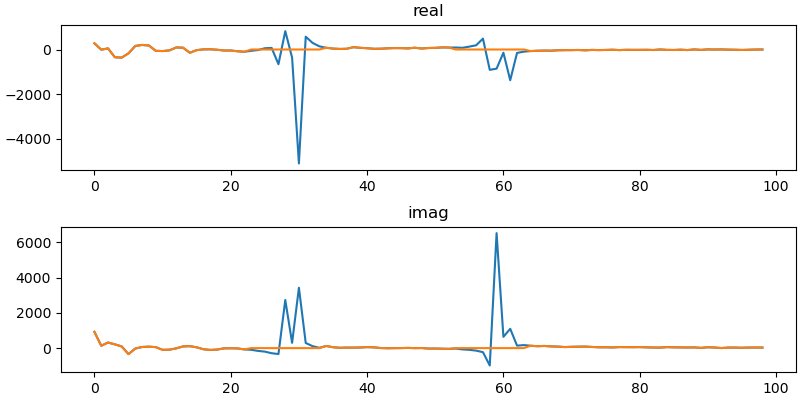Note
Click here to download the full example code
fourier_filter_example.py¶
- This script illustrates the following concepts:
Usage of geocat-comp’s fourier_filter function
Usage of geocat-datafiles for accessing NetCDF files
See following GitHub repositories to see further information about the function and to access data:
For fourier_filter function: https://github.com/NCAR/geocat-comp
For CO-OPS_9415020_wl.csv file: https://github.com/NCAR/geocat-datafiles/tree/main/ascii_files
- Dependencies:
geocat.comp
geocat.datafiles (Not necessary but for conveniently accessing the data file)
numpy
pandas
xarray
matplotlib
Import packages
import numpy as np
import pandas as pd
import matplotlib.pyplot as plt
import xarray as xr
import geocat.datafiles as gdf
from geocat.comp import fourier_filter
Read in data:
# Open a netCDF data file using xarray default engine and load the data into xarrays
dataset = xr.DataArray(pd.read_csv(
gdf.get("ascii_files/CO-OPS_9415020_wl.csv")))
xr_data = dataset.loc[:, 'Verified (ft)']
Plot:
# Set points per hour
data_freq = 10
# Set tide cycle and frequency resolution
tide_freq1 = 1 / (1 * 12.4206)
tide_freq2 = 1 / (2 * 12.4206)
res = data_freq / (len(xr_data))
# Define cutoff_frequency_low and cutoff_frequency_high based on tide frequency
cflow1 = tide_freq1 - res * 5
cfhigh1 = tide_freq1 + res * 5
cflow2 = tide_freq2 - res * 5
cfhigh2 = tide_freq2 + res * 5
# Generate figure with 1 subplot and set its size (width, height) in inches
fig, ax = plt.subplots(1, 1, dpi=100, figsize=(8, 4), constrained_layout=True)
# Load signal data and plot it
no_tide = xr_data
ax.plot(no_tide[2000:3000])
# Plot filtered signal data using fourier_filter for the first set of cutoffs
no_tide = fourier_filter(no_tide,
data_freq,
cutoff_frequency_low=cflow1,
cutoff_frequency_high=cfhigh1,
band_block=True)
ax.plot(no_tide[2000:3000])
# Plot filtered signal data using fourier_filter for the second set of cutoffs
no_tide = fourier_filter(no_tide,
data_freq,
cutoff_frequency_low=cflow2,
cutoff_frequency_high=cfhigh2,
band_block=True)
ax.plot(no_tide[2000:3000])
# Show figure
fig.show()
# Generate figure with 2 by 1 subplots and set its size (width, height) in inches
fig, axs = plt.subplots(2, 1, dpi=100, figsize=(8, 4), constrained_layout=True)
# Plot the real set of data utilizing NumPy's Fourier Transform function using both
# the original data and the fourier_filter applied to the second set of cutoffs
axs[0].set_title('real')
axs[0].plot(np.real(np.fft.fft(xr_data)[1:100]))
axs[0].plot(np.real(np.fft.fft(no_tide)[1:100]))
# Plot the imaginary set of data utilizing NumPy's Fourier Transform function using both
# the original data and the fourier_filter applied to the second set of cutoffs
axs[1].set_title('imag')
axs[1].plot(np.imag(np.fft.fft(xr_data)[1:100]))
axs[1].plot(np.imag(np.fft.fft(no_tide)[1:100]))
# Show figure
fig.show()
# Generate figure with 2 by 1 subplots and set its size (width, height) in inches
fig, axs = plt.subplots(2, 1, dpi=100, figsize=(8, 4), constrained_layout=True)
# Define start and end of data indices
start = 0
end = -1
# Plot the real and imaginary sets of data from the original and filtered data
axs[0].set_title('real')
axs[0].plot(np.real(xr_data)[start:end])
axs[0].plot(np.real(no_tide)[start:end])
axs[1].set_title('imag')
axs[1].plot(np.imag(xr_data)[start:end])
axs[1].plot(np.imag(no_tide)[start:end])
# Show plot
fig.show()
Total running time of the script: ( 0 minutes 0.783 seconds)


